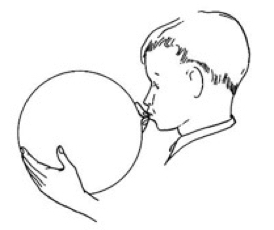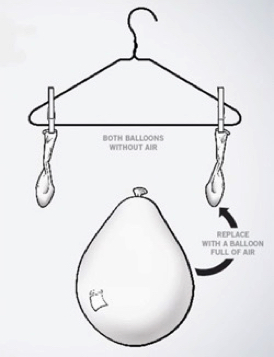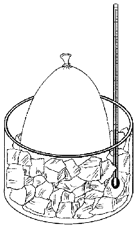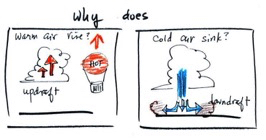— Air, Aerodynamics and Flight —



Air takes up space
Air has mass/weight
Air is affected by heat
Air exerts pressure
Air can be compressed
Air is affected by altitude
Air Takes Up Space
Take an empty Ziploc bag, open it and pull it through the air like a parachute. Now close it, seal it and try to squish the bag. There's nothing in the bag, right? Wrong. The Ziploc bag is full of air.
You can also prove this by blowing up a balloon. The balloon expands because you are putting something into the balloon; air. This air takes up space, so the more air you put into the balloon, the more space it takes up. When you use a pump to blow up a football, you don't put nothing into it, you put air into it - this air takes up space which is why the football expands.
Try it Yourself
Tube in a cup | Air Force | Diving Paper | Huff and Puff

Air Has Mass
Place an empty balloon on a scale and weigh it. Take this same ballon and inflate it. Weigh it again. What do you see?. A really clear way to show this is to make a balance with a stick or coat-hanger suspended by a string in the middle. Tie an empty balloon on each side to prove they weigh the same. Inflate one balloon and rehang it. That side of the balance will be heavier. If air had no mass, there would've been no change.
Air is really quite heavy. It is just that it has always been there for you and me so we do not notice. Asking a human if air is heavy is like asking a fish if water is heavy.
Every square inch of surface on the earth has about 15 pounds of air sitting on it. (Air is piled about 100 miles high on each square inch.) Just for fun, calculate the number of square inches on the top of your head and multiply it by 15. Wow... you are holding all that up!?!?

Try it Yourself
Balancing Act | Feel the Force
Air Exerts Pressure
Take a metre stick and lay it on a table. Unfold a full page of a newspaper and lay it flat over the metre stick. Push down on the other end of the metre stick. What happens? Why can't you lift a super-light piece of paper? Air exerts pressure (in all directions).
The air above the paper pushes down on it (pressure). This pressure is what makes the paper lay flat on the table - it's being pushed down. Even though they're too tiny to see, all the molecules of air in the atmosphere above your head weigh something. And the combined weight of these molecules causes a pressure pressing down on your body of 10,000 kg per square metre (10,000 kg = 22,000 lbs). This means that the mass of the air above the 0.1 square metre cross-section of your body is 1,000 kg or a tonne.
If you tried to lift a small car, you'd definitely notice it, so why don't we notice that there's a tonne of air pressing down on us? Well, the air exerts this force in all directions, so as well as pushing down on us, it also pushes up and balances out the force on our bodies so that we don't collapse.
Try it Yourself
Feel the Force | Test Your Strength I Unspillable Water
Air is affected by Temperature


Take a balloon and place it over the top of a pop bottle (2L is best with a little bit of water in it). Observe the size of the balloon now (@ room temperature). Now place it in a freezer for 10 minutes, remove it and observe the size of the balloon. Now take the bottle and hold it in a baking dish of almost-boiling water for 10 minutes. Now let the bottle sit on the table for 10 minutes. You should now see the balloon return to the same size as it was to start.
The greater the temperature, the faster the air particles move (increasing pressure), hitting the sides of the balloon more often and harder, making the balloon inflate more. The colder the air becomes though, the slower the air particles move (lowering pressure), resulting in the same amount of air now taking up less space. This is why the beach-ball you left in the garage overnight will be "smaller" in the morning that it was during the day (when it was warmer).
Try it Yourself


